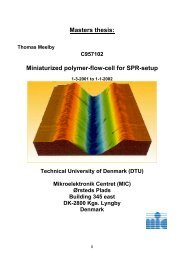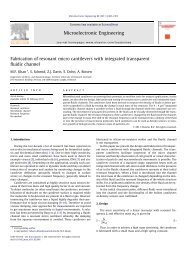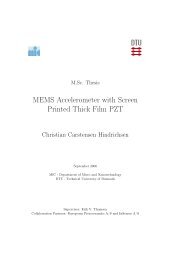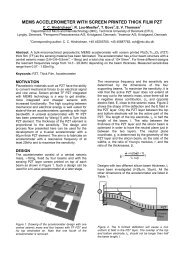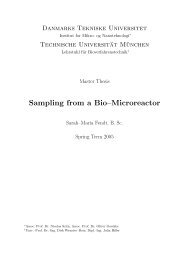Prototyping of microfluidic systems with integrated ... - DTU Nanotech
Prototyping of microfluidic systems with integrated ... - DTU Nanotech
Prototyping of microfluidic systems with integrated ... - DTU Nanotech
You also want an ePaper? Increase the reach of your titles
YUMPU automatically turns print PDFs into web optimized ePapers that Google loves.
2.4 Optical measurements in micr<strong>of</strong>luidics 19<br />
In practice, to determine the concentration <strong>of</strong> a given substance in<br />
a sample, different pre-treatment steps like filtering, aliquoting, and<br />
chemical reactions are made, so that one is certain that the readout<br />
from the instrument really stems from the substance, and that it is not<br />
altered by the presence <strong>of</strong> other substances.<br />
Furthermore, one needs a reference measurement - typically a sample<br />
<strong>of</strong> the solvent (e.g. water or ethanol) alone, and one or several <strong>with</strong><br />
known concentrations <strong>of</strong> the substance.<br />
In micr<strong>of</strong>luidic <strong>systems</strong> the reference can be solved in the same ways<br />
as when using macroscopic instruments. Either the same optical cuvette<br />
can measure the references and the samples sequentially, or the system<br />
can be parallelised, so that multiple structures measure on the sample<br />
and references simultaneously.<br />
An elegant, commercially available example <strong>of</strong> applied optical spectroscopy<br />
is the Radiometer NPT7 blood gas analyzer [15]. Several values,<br />
like pH and pCO2, are measured on a desktop sized device using singleuse<br />
polymer cartridges <strong>with</strong> <strong>integrated</strong> optical cuvettes. By making one<br />
side <strong>of</strong> the cuvettes flexible, several hundred optical measurements in<br />
the infrared part <strong>of</strong> the spectrum can be made <strong>with</strong> different absorption<br />
lengths, meaning that the optical loss from the system can be separated<br />
from the loss stemming from the sample. In this manner, no reference<br />
measurements or calibration are needed.<br />
2.4.1 Planar micr<strong>of</strong>luidics<br />
Most micr<strong>of</strong>luidic <strong>systems</strong> today are two-dimensional or 2.5-dimensional,<br />
which roughly means that the structure can be manufactured from<br />
one side using e.g. clean room processing or micro milling. If more<br />
complicated three-dimensional structures are needed, they are usually<br />
fabricated by stacking layers <strong>of</strong> 2.5-dimensional structures. For many<br />
applications, the use <strong>of</strong> <strong>systems</strong> <strong>with</strong> a single, fixed channel depth for<br />
the entire system, is sufficient.<br />
Several methods for integrating optical detection in micr<strong>of</strong>luidics<br />
exist. The micr<strong>of</strong>luidic system can either be inserted in a macroscopic<br />
setup, where a light source shines light through a cuvette perpendicular<br />
to the micr<strong>of</strong>luidic substrate. The light is then detected by e.g. a<br />
spectrometer on the other side. Using this approach, the length <strong>of</strong><br />
the optical cuvette is defined by the thickness <strong>of</strong> the substrate, and is<br />
therefore relatively short – typically in the order <strong>of</strong> 1 mm. By coupling<br />
light into the plane <strong>of</strong> the substrate, the optical path can be prolonged



